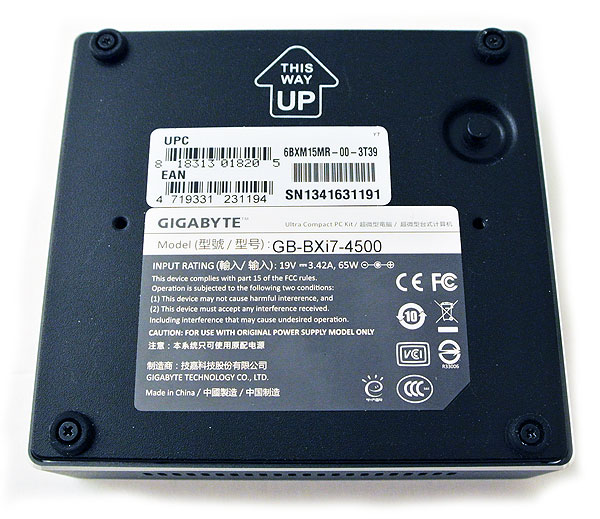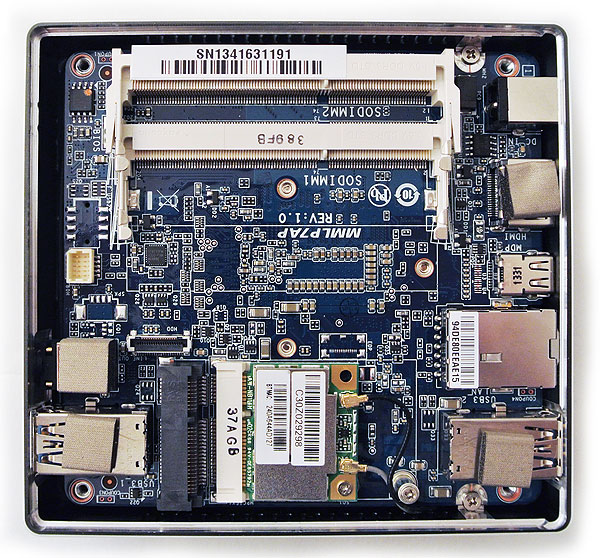Seven Small (But Powerful) Mini-PCs, Reviewed
Gigabyte Brix GB-BXi7-4500
Why you can trust Tom's Hardware
Gigabyte isn't the first company we think of when the conversation switches to small PCs, but the company is working hard to impress with its Brix product line. The goal appears to be to best Intel at its own game (even though we know that, in reality, both companies work closely together). The Brix is slightly smaller and significantly lighter than Intel's offering. Gigabyte further mixes things up with some interesting configuration options: the BXPi3-4010 features an integrated WVGA (864x480) projector, while the BXA8-5545 may be the closest thing to an AMD-based NUC, equipped with an A8-5545M APU with on-die Radeon 8510G graphics. We also have the Brix Pro in our lab, outfit with a Core i7-4770R that includes Iris Pro graphics 5200.
The model we're reviewing today is the BXi7-4500, featuring Intel's Haswell-based Core i7-4500U with 4 MB of shared L3 cache, a 1.8 GHz base clock rate, and a 3 GHz Turbo Boost ceiling. Somewhat disappointingly, the Core i7-4500U is equipped with HD Graphics 4400, rather than GT3/GT3e GPU. As a result, our expectations of graphics performance aren't very high.
The BXi7-4500 is currently available on Newegg for $530 as a barebones system. Adding Windows 8.1 Pro x64 OEM, Intel's SSD 525 180 GB, and 8 GB of Crucial DDR3 brings the price as tested to $954.98.
Bundle And First Impression
Bundled inside the box, you'll find the Brix mini-PC, a VESA mount, an AC adapter and power cable, documentation, and a driver CD. While Intel gives you the AC adapter with its NUC, you don't get a power cable (though in our meeting with Intel at CES this year, company representatives mentioned this is changing), so Gigabyte gets credit for its more complete kit. The VESA adapter plate is used to mount the Brix on a monitor, if you want it out of sight.
Gigabyte's styling looks a lot like Intel's design, with the added flair of a silver accent around the Brix's top edge. At 1.2" x 4.2" x 4.5" and 0.8 lbs, this is the smallest and lightest mini-PC in our round-up. In fact, it's only about 75% as heavy as the previous-gen Ivy Bridge-based NUC.
The front of this Brix is kept fairly simple; there are two USB 3.0 ports, and a combo headphone and S/PDIF jack. You can also see the power button up top.
Around back, there's an AC power connector, HDMI output, mini-DP output, GbE jack, and two more USB 3.0 ports.
This is the bottom of the Brix. See the nub in the upper right-hand corner? That little handle makes it easier to pull off the bottom cover compared to Intel's NUC.
If it wasn't for the blue Gigabyte motherboard, you might assume you were looking inside Intel's mini-PC. The basic configuration is the same: there are two SO-DIMM slots for dual-channel DDR3 configurations, a mini-PCIe slot on the opposite end of the board, with an mSATA slot next to it. Although this is a barebones kit that requires memory and a hard drive, Gigabyte does give you a Wi-Fi/Bluetooth combo card. We're a little disappointed that it's a Realtek RTL8723AE-based controller limited to the 802.11n standard instead of ac, but at least Bluetooth 4.0 is supported.
Note that platforms based on mobile Haswell only support 1.35 V SO-DIMMs; your older 1.5 V DDR3 modules won't work. Check out Haswell And 1.35 V Memory: Three DDR3 SO-DIMM Kits, Tested for more information on performance at each data rate with Intel's newest architecture.
Special Features And Livability
It seems like Gigabyte's Brix is the company's attempt to improve on Intel's NUC while making it even smaller. Although the company's design tweaks are evident, they aren't particularly impactful, either. Having said that, the inclusion of a power cable, a bundled Wi-Fi/Bluetooth adapter, and the bottom cover handle earn the Brix favor, all else being equal. They're not, though. The $530 BXi7-4500 is more expensive than Intel's $375 Haswell-based NUC D54250WYK on Newegg. The BXi5-4200 at $390 is a closer match, though. Comparing those two sub-$400 competitors, the Brix has a higher base clock, while the NUC gives you HD Graphics 5000 (making gaming a much more viable possibility). Regardless of your choice, the match-up is much closer.
| Header Cell - Column 0 | Gigabyte Brix GB-BXi7-4500 |
|---|---|
| Chipset | Intel HM87 Express |
| CPU | Intel Core i7-4500U, Dual-Core, Hyper-Threaded, 1.8 GHz (3.0 GHz Peak Turbo Boost), 4 MB Shared L3 Cache |
| Graphics | Intel HD Graphics 4400, 200 MHz - 1.1 GHz |
| GraphicsMemory | Shared with system memory |
| SystemMemory | Not Included |
| Hard Drive | Not Included |
| Optical Drive | N/A |
| Operating System | Not Included |
| Included Peripherals | Not Included |
| Internal Interfaces | |
| Memory Support | Dual-Channel, 2 x DDR3L SO-DIMM slots, 1.35 V, 1333/1600 MT/s, 16 GB Max |
| Mini-PCIe | One slot (occupied by bundled wireless card) |
| mSATA | One slot |
| Mass Storage Controllers | |
| Chipset SATA | 1 x mSATA 6Gb/s |
| I/O Panel Connectors | |
| DVI | Not Included |
| VGA | Not Included |
| HDMI | 1 |
| DisplayPort | 1 (mini-DP) |
| Thunderbolt | Not Included |
| MHSL Input | Not Included |
| USB | 4 x USB 3.0 |
| Memory Card Reader | Not Included |
| Network | 1 |
| eSATA | Not Included |
| Digital Audio out | S/PDIF jack/HDMI |
| Analog Audio | 1 front |
| IR Sensor | Not Included |
| Ethernet & Wireless | |
| LAN | Integrated Gigabit |
| Wi-Fi | 1T1R Single Band, Realtek RTL8723AE 802.11n, mini-PCIe card |
| Bluetooth | Integrated Bluetooth 4.0, Realtek RTL8723AE Wi-Fi Combo card) |
| Audio | |
| HD Audio Codec | Analog and S/PDIF: Realtek ALC269HDMI: Intel Display Audio |
| Audio Channels | 2+2 Channel HD Audio Codec |
| Physical Specifications | |
| Size | 29.9 x 107.6 x 114.4 mm(1.18" x 4.24" x 4.5") |
| Weight | 371 g (0.82 lbs) |
| Price | |
| As tested $954.98 (with Windows 8.1 Pro x64, Intel SSD 525 180 GB SSD, and 2 x 4 GB Crucial DDR3 SO-DIMMs |
Current page: Gigabyte Brix GB-BXi7-4500
Prev Page ASRock VisionX 420D-8G1T88 Next Page Intel NUC DC3217IYE (Ivy Bridge)Get Tom's Hardware's best news and in-depth reviews, straight to your inbox.
Don Woligroski was a former senior hardware editor for Tom's Hardware. He has covered a wide range of PC hardware topics, including CPUs, GPUs, system building, and emerging technologies.
-
outlw6669 Not a single AMD based SFF PC?Reply
I am disappoint, this would be a great area for AMD to show their competitiveness. -
ta152h @outlw6669I built one based on the A6 5200, and it's perfect for what I need it for. It's low power, more than fast enough for what 99% of the people do, quiet, and inexpensive. I'm a little surprised they didn't choose something based on the Jaguar for that reason, but it might just be a situation where nothing with one was sent to them for review. Certainly this is a poor representation, without both Jaguar and Bay Trail missing. I got to the first page, read what they had, looked at the cases, and moved on. Reading about different versions of Ivy Bridge and Haswell and how they compare to each other is profoundly uninteresting.Reply -
m32 I wouldn't mind having a small system like this. Maybe Mid-Year when everyone's CPU/APUs are out, I'll have the chance to make a smart buy. Thanks for the article. :)Reply -
mesab66 It is interesting that by going slightly larger with the enclosure space (still keeping within cube/rectangle/media player shape) opens up the possibility of so much more power....dedicated gfx, full cpu, etc etc., and, can be cheaper to build - depending on the users requirements.......of course, at the cost of power requirements, etc. I'm thinking most folk would ideally chose a slightly larger form factor for living room/media pc duties.On the other hand, if constraints are tight (form factor in this article) and the end user's requirements match, then these options are worth considering.Reply -
s997863 Power. I don't care about no power. Where's the love for the old games? If I want to play some of the classics which just don't emulate properly, I have to hunt for a heavy old Pentium3 box and try to get it working. How about a cheap mini PC with miniaturized legacy hardware for full compatibility to dual-boot win98 & XP, with gameports, VGA & S-Video, PS/2 & USB, IDE & SATA external ribbon & power connectors, & a turbo button for choosing between 2 processors 200MHz & 3GHz?Reply -
vertexx I am a huge fan of compact systems. Almost everything I have built has been ITX. But I've had a hard time with the NUC form factor. As a desktop, I think it's actually too small. One of those boxes would get lost on my desk, continuously being pushed around by other clutter. Now, if I had a hutch with an optimally sized cubby, that might be a different story.Reply
VESA mounted on the back of a monitor, these look really clunky, and I'd rather go with an AIO kit using the thin mini-ITX form factor where I have more control over processor choice.
I'd be more excited if this technology and form factor were applied in a more interchangeable system with a standardized GPU socket. I really like what ASRock and Gigabyte have done with their compact systems. They're not as compact, but having something a little more substantial on my desk is a good thing, and they pack a lot of punch. I just wish the standards were developed to allow builders to replicate that feat - pipe dream, I know.
One thing is for sure, AMD needs to develop it's own equivalent of the NUC and thin Mini-ITX. The success of it's Kaveri line I think would be helped out by innovation in form factor. -
axehead15 I think you should compare the Mac Mini to these, that way we can see how it adds up.Reply




